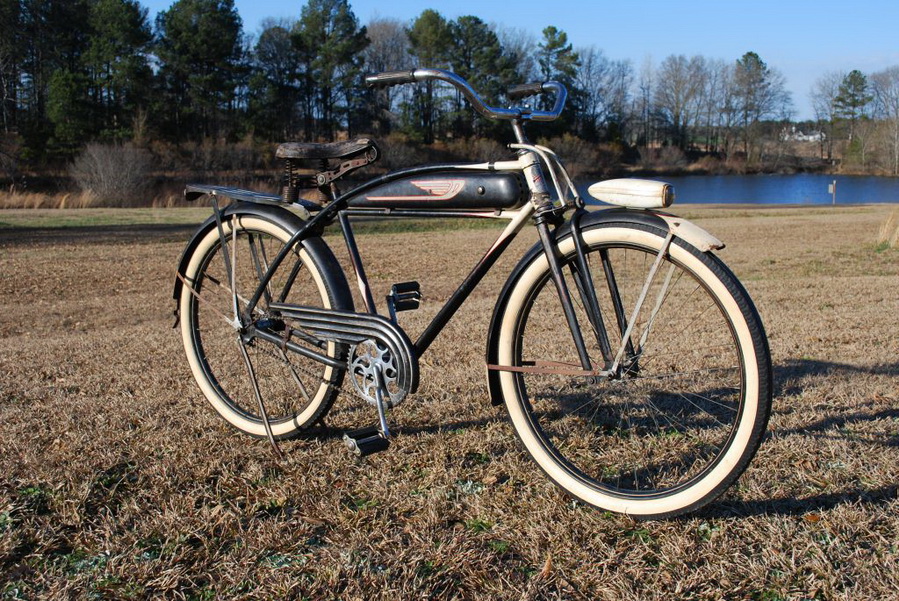

"MYTHS AND BIZARRE MISCONCEPTIONS ABOUT PIERCE AND So-CALLED 'PIERCE-ARROW' BICYCLES". SEE THE SECTION OF GTCC ON THE PIERCE BICYCLE CONTROVERSY. An arrow SYMBOL was shown in the logo, but the word, "arrow" was never used in conjunction with bicycles made by this company. Although the companies were originally related, the bicycle did not say the word, "ARROW", nor did the catalogues. The bicycle was simply known as "PIERCE," not Pierce-Arrow. : The bicycle shown is referred to as a "Pierce-Arrow". Pretending otherwise, perverting the evolution or graying of the term in the 1990s does not change the facts of this bicycle history. Acknowledgements: The collector terminology "classic bicycles" for collector bicycles was coined, established and copyrighted in the 1970s by Leon Dixon- who curiously is not mentioned, despite use of his terminology and concept. The "tear drop pedals" referred to are not correct for the bicycle, but instead are aftermarket units never originally equipped on this model.
#Monark bicycles history series
The Speedline series did not begin until 1938 and the model term, "Airflo" (without the "w") was not used by Shelby in 1936. The same paragraph goes on to refer to a "1936 Shelby Speedline Airflo" when in fact the bicycle shown is a 1939 Speedline Airflo. There is further reference to the "prominent horn" which, unfortunately, is in the wrong position on the handlebars when it should be on a special bracket in front of the truss rods. COLUMBIA was merely the name of the premium line of bicycles made and sold by Westfield). In reality, the Elgin Blackhawk was a product of Sears, Roebuck & Company and it was built according to Sears' specifications under contract by Westfield Manufacturing Company (there was no Columbia Manufacturing Company at that time. (facing the contents page): In the back cover explanation the statement is that the 1934 Elgin Blackhawk was from the Columbia Manufacturing Company. it actually worked better, was less subject to damage, was more ingenious and tracked smoother. Furthermore, the book states that the '52 Roadmaster had a "new brake light" when in fact the Roadmaster already had an electric brake light at least by the late 1930s and every year following! Finally, the Roadmaster suspension did not merely "rival" Schwinn's suspension. The first Schwinn Phantom did not appear until late that year. In the case of the Roadmaster and the Luxury Liner, Schwinn was imitating Roadmaster, Not Roadmaster imitating Schwinn! Cleveland Welding Company and Roadmaster had a model out with spring fork, electric brake light and chrome fenders by the start of the 1949 model year. (facing Contents page): In the title page explanation and in reference to Schwinn there is a statement implying that other manufacturers were "trying to keep up with Schwinn" (an absurd thing to say) when in fact the opposite is true. Fender braces have been chromed, but originals were cad plated. The paint job on the chainguard is 1953.but the logo decal is 1952. The correct stop light switch mechanism and electricals for 1952 all appear to be missing. The pedals are 1970's imports never used on the Luxury Liner. Title Page: The Roadmaster shown has also been displayed in several other publications. The rear brake cable is routed improperly. the handlebars with the tight and primitive mandrel bends appear to be imported 1980s cruiser bars and are not bent as originals. and so goes the classic bicycle hobby and books about it.Ĭover: The Schwinn Phantom pictured has been seen numerous times in print. But when nobody knows any better, anyone can therefore be an "expert". Frankly, sadly, much of it is pure fiction.

By all means, read this book and look at the pictures as interesting entertainment, but do not accept it as authoritarian "history." It is not.

The worst part of all is much novice and amateur opinion disguised as fact. and the readers probably think they've received an education. and there are people out there quoting from it every day. But that didn't stop it from selling well. THERE ARE MORE! Like almost all of the books on the classic bicycle hobby, this one is a disaster. NOTE: THE FOLLOWING ARE NOT ALL OF THE ERRORS IN THIS BOOK. No part of these corrections may be republished, excerpted, referred to in print, used in any way unless written permission from the author has been provided and acknowledgments are made. If you use them without getting permission first, you are violating federal copyright laws. CAUTION! WE ARE WATCHING, SO WATCH YOUR CREDIT LINE! THESE CORRECTIONS ARE INTELLECTUAL PROPERTY. Email us at: GUIDE TO CORRECTING THE CLASSICSĮRROR CORRECTIONS TO THE BOOK, "CLASSIC AMERICAN BICYCLES" by Pridmore, published by Motorbooks International FOLLOW.Ĭopyright © Leon Dixon/NBHAA 1999, 2004, 2007, 2009.


 0 kommentar(er)
0 kommentar(er)
